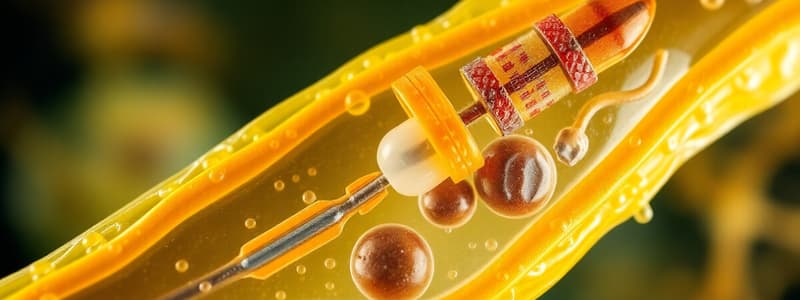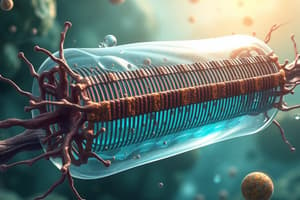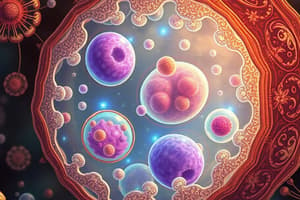Podcast
Questions and Answers
Which of the following statements about the size of cells is incorrect?
Which of the following statements about the size of cells is incorrect?
- Human red blood cells are about 7.0um in diameter, making them among the largest cells in the human body. (correct)
- Bacteria are typically between 3 and 5 um in length.
- The smallest cells are Mycoplasma, measuring 0.3um in length.
- The largest single cell is the egg of an ostrich.
What is the primary method by which cells obtain nutrients, exchange gases, and regulate water balance?
What is the primary method by which cells obtain nutrients, exchange gases, and regulate water balance?
- Active Transport
- Diffusion (correct)
- Endocytosis
- Exocytosis
What is the name given to the specific components within a cell that perform specialized functions?
What is the name given to the specific components within a cell that perform specialized functions?
- Tissues
- Cell Organelles (correct)
- Organisms
- Chromosomes
Which of the following is not a type of cell environment?
Which of the following is not a type of cell environment?
In which process does water move from a region of high concentration to a region of low concentration through a semipermeable membrane?
In which process does water move from a region of high concentration to a region of low concentration through a semipermeable membrane?
What is the primary function of the plasma membrane?
What is the primary function of the plasma membrane?
How is the size and shape of a cell related to its function?
How is the size and shape of a cell related to its function?
Which type of transport requires energy (ATP) to move substances across a membrane against their concentration gradient?
Which type of transport requires energy (ATP) to move substances across a membrane against their concentration gradient?
What is the main difference between a unicellular freshwater organism and a plant cell in terms of water balance?
What is the main difference between a unicellular freshwater organism and a plant cell in terms of water balance?
What happens to a cell placed in a hypotonic solution?
What happens to a cell placed in a hypotonic solution?
Which of these is a characteristic of passive transport?
Which of these is a characteristic of passive transport?
Which of the following is NOT a cellular waste product?
Which of the following is NOT a cellular waste product?
Which process moves substances from a region of low concentration to a region of high concentration?
Which process moves substances from a region of low concentration to a region of high concentration?
In which type of solution would a cell remain the same size?
In which type of solution would a cell remain the same size?
Which of the following is an example of active transport?
Which of the following is an example of active transport?
Which of the following components is NOT part of the cytoplasm?
Which of the following components is NOT part of the cytoplasm?
What is the primary function of the cell membrane?
What is the primary function of the cell membrane?
What is the main function of the nucleus?
What is the main function of the nucleus?
What is the function of the pores in the nuclear membrane?
What is the function of the pores in the nuclear membrane?
What is the composition of the cell membrane?
What is the composition of the cell membrane?
What is the role of cholesterol in the cell membrane?
What is the role of cholesterol in the cell membrane?
Which of the following is NOT a component of the cytoplasm?
Which of the following is NOT a component of the cytoplasm?
What is the role of the nucleus in cell reproduction?
What is the role of the nucleus in cell reproduction?
Which of the following components is NOT directly involved in the structural support and motility of the cell?
Which of the following components is NOT directly involved in the structural support and motility of the cell?
Which of the following statements about the cytoplasm is TRUE?
Which of the following statements about the cytoplasm is TRUE?
What is the primary difference between the nucleus in eukaryotic cells and the nucleoid in prokaryotic cells?
What is the primary difference between the nucleus in eukaryotic cells and the nucleoid in prokaryotic cells?
What is the function of the Golgi apparatus within the cell?
What is the function of the Golgi apparatus within the cell?
Which of the following is NOT considered an inclusion within the cytoplasm?
Which of the following is NOT considered an inclusion within the cytoplasm?
Based on the content provided, what is the most abundant component of the cytoplasm, followed by the second most abundant?
Based on the content provided, what is the most abundant component of the cytoplasm, followed by the second most abundant?
Which of the following is a function of the protein fibers within the cytoskeleton?
Which of the following is a function of the protein fibers within the cytoskeleton?
What is the primary function of histone proteins in the context of DNA?
What is the primary function of histone proteins in the context of DNA?
Which of the following is NOT a function of the centrosome in animal cells?
Which of the following is NOT a function of the centrosome in animal cells?
What component of the cell membrane plays a crucial role in the fluid mosaic model, allowing for its fluidity and flexibility?
What component of the cell membrane plays a crucial role in the fluid mosaic model, allowing for its fluidity and flexibility?
Genetic information is passed from one generation to the next in the form of:
Genetic information is passed from one generation to the next in the form of:
What is the primary function of genes within a DNA molecule?
What is the primary function of genes within a DNA molecule?
What is the main function of chromatin fibers in the nucleus?
What is the main function of chromatin fibers in the nucleus?
Why is the arrangement of phospholipids in the cell membrane described as a "bilayer"?
Why is the arrangement of phospholipids in the cell membrane described as a "bilayer"?
According to the fluid mosaic model, what contributes to the "mosaic-like" structure of the cell membrane?
According to the fluid mosaic model, what contributes to the "mosaic-like" structure of the cell membrane?
Which of these statements about the cell wall in bacteria is TRUE?
Which of these statements about the cell wall in bacteria is TRUE?
What is the primary function of the glycocalyx in bacteria cells?
What is the primary function of the glycocalyx in bacteria cells?
Which component is NOT found in the cell wall of plants?
Which component is NOT found in the cell wall of plants?
What is the primary structural component of algae cell walls?
What is the primary structural component of algae cell walls?
Mesosomes are analogous to which organelle in eukaryotic cells?
Mesosomes are analogous to which organelle in eukaryotic cells?
What is the function of the hook in a bacterial flagellum?
What is the function of the hook in a bacterial flagellum?
Which of the following is NOT a function of the cell wall in general?
Which of the following is NOT a function of the cell wall in general?
What is the primary structural component of the fungal cell wall?
What is the primary structural component of the fungal cell wall?
Flashcards
Cell Organelles
Cell Organelles
Specific components within a cell that perform distinct functions.
Plasma Membrane
Plasma Membrane
The outer boundary of a cell that controls what enters and exits.
Nucleus
Nucleus
The cell's control center, containing genetic material.
Diffusion
Diffusion
Signup and view all the flashcards
Hypotonic
Hypotonic
Signup and view all the flashcards
Hypertonic
Hypertonic
Signup and view all the flashcards
Isotonic
Isotonic
Signup and view all the flashcards
Osmosis
Osmosis
Signup and view all the flashcards
Cell Membrane
Cell Membrane
Signup and view all the flashcards
Cytoplasm
Cytoplasm
Signup and view all the flashcards
Selectively Permeable
Selectively Permeable
Signup and view all the flashcards
Phospholipid Bilayer
Phospholipid Bilayer
Signup and view all the flashcards
Cytosol
Cytosol
Signup and view all the flashcards
Organelles
Organelles
Signup and view all the flashcards
Cell Division
Cell Division
Signup and view all the flashcards
Cytoskeleton
Cytoskeleton
Signup and view all the flashcards
Nucleoid
Nucleoid
Signup and view all the flashcards
Chromatin
Chromatin
Signup and view all the flashcards
Chromosomes
Chromosomes
Signup and view all the flashcards
Inclusions
Inclusions
Signup and view all the flashcards
Centrosome
Centrosome
Signup and view all the flashcards
Centrioles
Centrioles
Signup and view all the flashcards
Histone proteins
Histone proteins
Signup and view all the flashcards
Nucleosomes
Nucleosomes
Signup and view all the flashcards
Fluid Mosaic Model
Fluid Mosaic Model
Signup and view all the flashcards
Phospholipids
Phospholipids
Signup and view all the flashcards
Active Transport
Active Transport
Signup and view all the flashcards
Passive Transport
Passive Transport
Signup and view all the flashcards
Hypotonic Solution
Hypotonic Solution
Signup and view all the flashcards
Hypertonic Solution
Hypertonic Solution
Signup and view all the flashcards
Isotonic Solution
Isotonic Solution
Signup and view all the flashcards
Concentration Gradient
Concentration Gradient
Signup and view all the flashcards
Cell Wall (Algae)
Cell Wall (Algae)
Signup and view all the flashcards
Cell Wall (Plants)
Cell Wall (Plants)
Signup and view all the flashcards
Cell Wall (Bacteria)
Cell Wall (Bacteria)
Signup and view all the flashcards
Glycocalyx
Glycocalyx
Signup and view all the flashcards
Cell Wall (Fungi)
Cell Wall (Fungi)
Signup and view all the flashcards
Mesosomes
Mesosomes
Signup and view all the flashcards
Flagellum
Flagellum
Signup and view all the flashcards
Cell Envelope (Bacteria)
Cell Envelope (Bacteria)
Signup and view all the flashcards
Study Notes
Cell Structure and Function
- Cells are the basic structural and functional units of all living things
- Cell theory states that all cells arise from pre-existing cells
- The cell theory was developed by Robert Hooke, Anton van Leeuwenhoek, Matthias Schleiden, Theodor Schwann, and Rudolf Virchow
- Cells have varying shapes and sizes, reflecting their specific functions
- Unicellular organisms consist of a single cell, while multicellular organisms contain many cells with specialized functions
- Examples of unicellular organisms are Amoeba, Chlamydomonas, Paramecium, and Bacteria
- Examples of multicellular organisms are plants, animals, and fungi
Cell Components
- Cell membrane: Encloses the cell contents, selectively permeable
- Cytoplasm: Gel-like substance inside the cell membrane, containing organelles
- Cytosol: Fluid portion of cytoplasm
- Organelles: Structures within the cytoplasm that perform various cell functions
- Mitochondria: Powerhouses of the cell, generating energy
- Ribosomes: Sites of protein synthesis
- Endoplasmic reticulum (ER): Network of membranes, involved in protein and lipid synthesis
- Rough ER: studded with ribosomes
- Smooth ER: lacks ribosomes, synthesizes lipids
- Golgi apparatus: Modifies, sorts, and packages proteins and lipids
- Lysosomes: Contain digestive enzymes, break down waste and foreign materials
- Vacuoles: Membrane-bound sacs involved in storage and transport
Cell Components (Continued)
- Nucleus: Control center of the cell, containing DNA organized into chromosomes
- Nucleolus: Part of the nucleus where ribosomes are assembled
- Cytoskeleton: Network of protein filaments that provide structural support and facilitate cell movement
Cell Types
- Prokaryotic cells: Lack a membrane-bound nucleus and other membrane-bound organelles (bacteria)
- Eukaryotic cells: Contain a membrane-bound nucleus and other membrane-bound organelles (plants, animals, fungi)
Cell Division
- Mitosis: Cell division process resulting in two identical daughter cells, crucial for growth and repair
- Meiosis: Cell division resulting in four haploid cells, essential for sexual reproduction
Plant vs Animal Cells
- Plant cells: Characterized by a cell wall, chloroplasts, and a large central vacuole
- Animal cells: Lack a cell wall and chloroplasts
Cells and External Environment
- Diffusion: Passive movement of substances from high to low concentration
- Osmosis: Passive movement of water across a selectively permeable membrane from low to high solute concentration
- Hypotonic: Solution with a lower solute concentration than the cell
- Hypertonic: Solution with a higher solute concentration than the cell
- Isotonic: Solution with the same solute concentration as the cell
Additional Information
- Cell size varies considerably, impacting function and activity
- Some cells are long and others short
- Complex cells have a number of organelles with specialized purposes
- The shape and size of cells are related to the specific function they perform
Studying That Suits You
Use AI to generate personalized quizzes and flashcards to suit your learning preferences.




